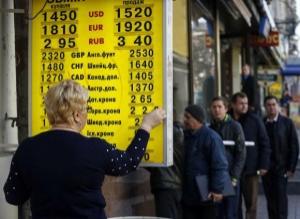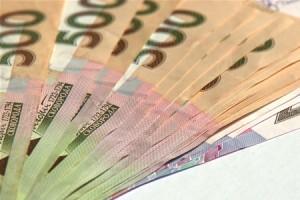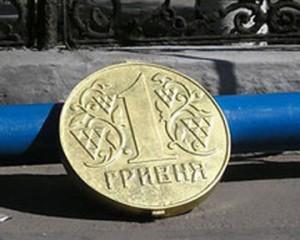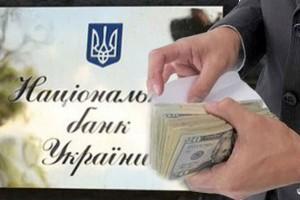Ukraine’s currency plunges as ceasefire fears grow

(Reuters) — Ukraine’s currency lost nearly 5 percent of its value on Monday after a weekend that saw the heaviest shelling in a month hit the main rebel stronghold in the east and signs that Moscow had dispatched troops and tanks to reinforce separatists.
The prospect that a two-month-old ceasefire could collapse and all-out war return to eastern Ukraine has weighed down the economy and helped drive the currency 12 percent lower since the central bank abandoned an unofficial peg a week ago.
The country of 46 million people is near bankruptcy, dependent on international loans, and deeply in debt for natural gas to Russia, the former imperial master it accuses of waging war on behalf of separatists on its territory.
The central bank offered to sell dollars on Monday at 15.2 hryvnias to the dollar, an all-time low and 4.8 percent lower than the last auction on Friday.
The bank abandoned a peg of 12.95 to the dollar a week ago, leaving the currency in free-fall. It said on Monday it believed the fall would now stop and the currency would settle between 15 and 16 to the dollar.
After fighting over the summer that killed 4,000 people, a truce has largely held between government forces and separatists in the east. But it appears to be fraying in recent days.
Kiev says Moscow has sent an armored column of additional reinforcements to aid the pro-Russian separatists in enclaves populated mainly by Russian-speaking ethnic Ukrainians, which the Kremlin now refers to as «New Russia».
Moscow denies that its troops have fought in Ukraine, even though many of them have died there.
The Organization for Security and Cooperation in Europe, a body that includes Russia, Ukraine, the United States and Western European countries and operates in east Ukraine with the permission of all sides, confirmed that a column of troops and tanks without insignia had been spotted in rebel held territory.
Reuters reporters in Donetsk, the biggest city in rebel held territory, said sporadic shelling could still be heard on Monday, although not as intense as Sunday when it reached a level unseen since early October.
The artillery fire has come from territory held by both sides, mainly near the ruins of the city’s airport, which is still held by government forces.
The United States and European Union have imposed economic sanctions on Moscow since Russia seized Ukraine’s Crimea peninsula in March and began backing pro-Russian rebels who rose up in two eastern provinces.
The past week has seen the truce deteriorate, after the rebels staged elections and inaugurated leaders, steps Kiev said violated a Sept. 5 peace agreement.
Western countries believe Russia aims to establish a «frozen conflict»: a separatist enclave similar to breakaway regions its troops have protected in much smaller ex-Soviet republics Georgia and Moldova for two decades.
That would make it more difficult for Ukraine to achieve its goal of joining the EU and weigh on efforts to revive an economy shattered by a year of political turmoil and war.
Kiev’s fear is that Russia will try to expand the territory controlled by the separatists with another military push like one that turned the war’s tide in the rebels’ favor in August.
The immediate economic concern for Ukraine is the currency, as the sharp fall imperils its banks. The central bank abandoned its unofficial peg last week after spending $1.3 billion, around a tenth of its remaining reserves, to defend the hryvnia in the past month and a half.
«They’re trying to show us that we have a floating exchange rate, but I prefer the term ‘sinking’ … the market is in a phase that could be classified as panic-mode,» a banker for a foreign bank’s subsidiary in Ukraine told Reuters.
German Foreign Minister Frank-Walter Steinmeier warned on Monday that the situation in the east had again become serious and made a new call for the ceasefire to be implemented.
Ukrainians’ faith in the banking system has sunk as the hryvnia declined. As of Sept. 21, around a third of deposits had been withdrawn from bank accounts this year, amounting to around 100 billion hryvnia ($6.8 billion).
This outflow has not abated, said Oleksandr Valchyshen of InvestCapital Ukraine.
«Bank recapitalisation must be more than cosmetic … depositors have to be assured that the bank is going to work without problems,» he said.
Efforts to support the hryvnia during the crisis and payments for Russian natural pushed foreign reserves to $12.6 billion as of October, their lowest since 2005.
Ukraine still has to pay Russian gas debts of $1.6 billion by the end of the year as well as over $700 million a month for new supplies. The next loan tranche under a $17-billion-dollar International Monetary Fund Program bailout program is likely to be delayed until the end of 2014 or next year.
Some experts say that will not be enough. Ukraine is «already at most people’s worst case for the year. The IMF program now needs totally recalibrating,» Standard Bank analyst Tim Ash said.
Источник: IPnews
IMF: Ukraine slashed gold holdings in October
Ukraine slashed its gold reserves by more than a third in October, data from the International Monetary Fund showed, asHryvnia currency hits all-time low
Ukraine’s hryvnia closed at a historic low against the dollar on Friday, after the central bank reined in its supportUkraine’s currency reserves plummet 23 percent to
Ukraine’s foreign currency reserves plummeted by almost a quarter month-on-month in October to $12.6 billion, theUkraine’s currency reserves fall 23 pct to $12.6 bln in
(Reuters) — Ukraine’s foreign currency reserves plummeted by almost a quarter month-on-month in October to $12.6Нет комментариев.
Информация
Посетители, находящиеся в группе Гости, не могут оставлять комментарии к данной публикации.



